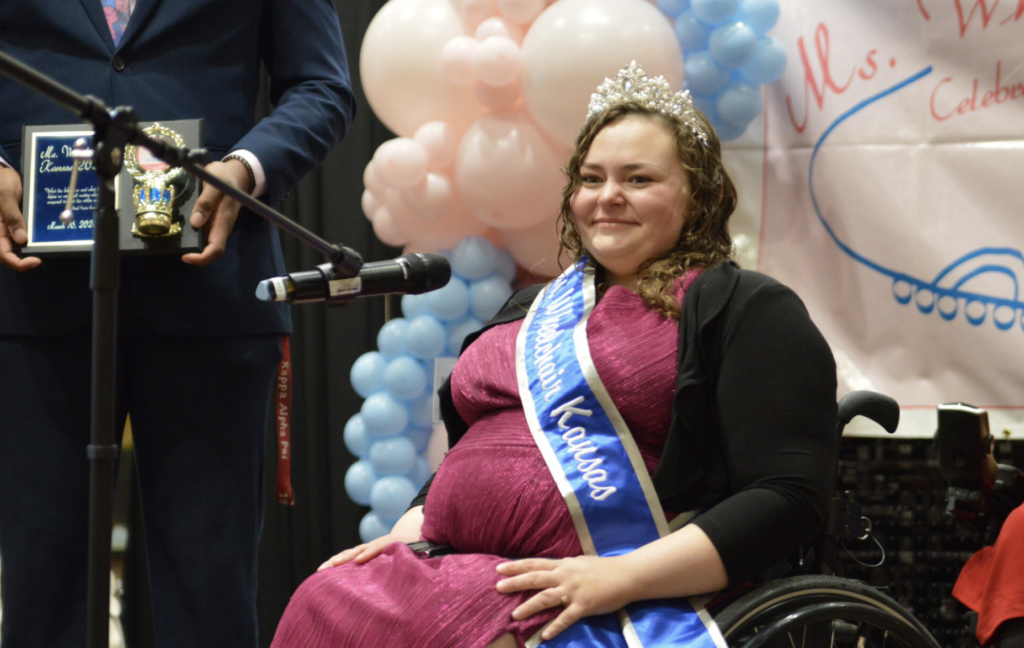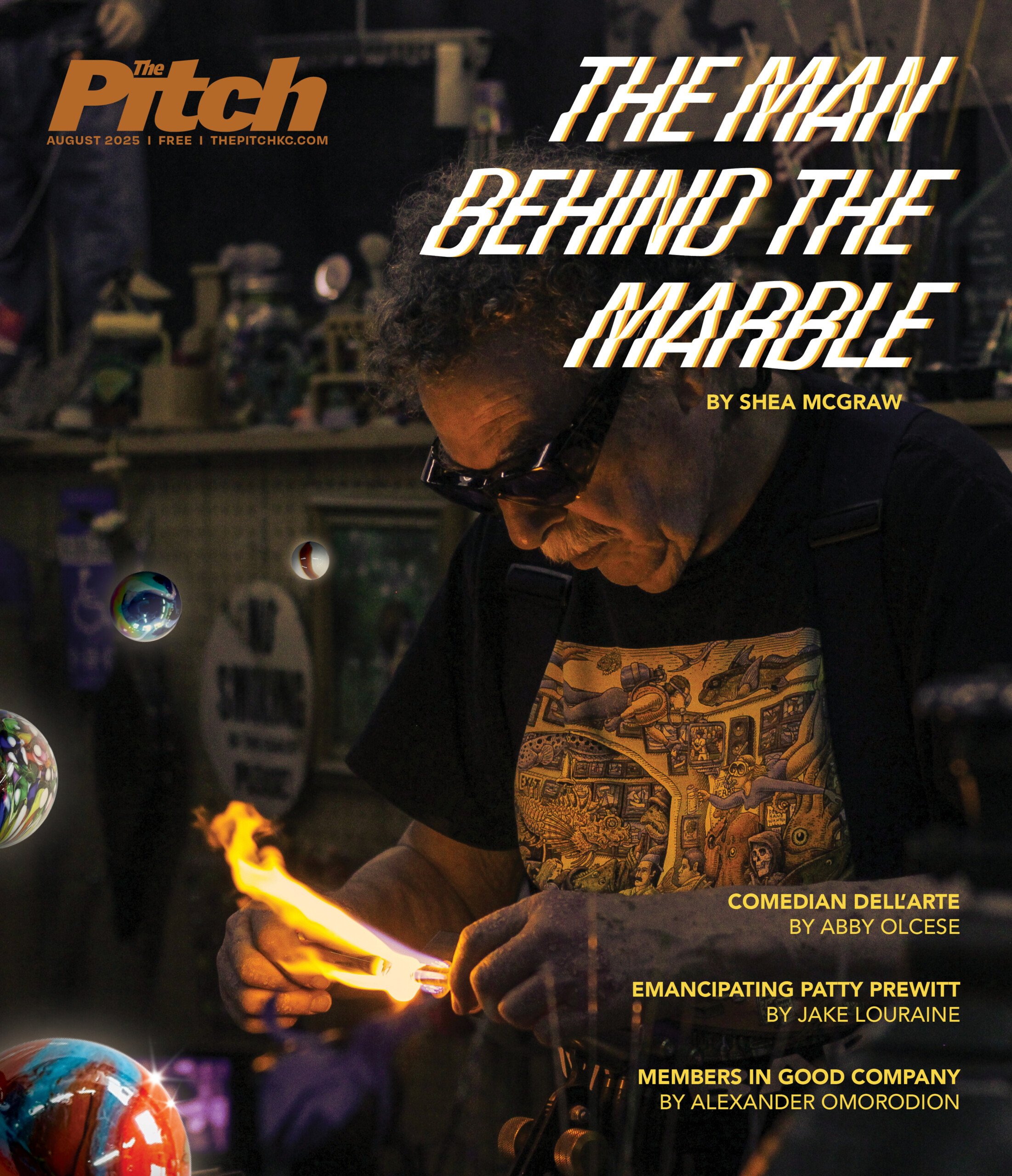Ring of Fire
A guy sure looks cool when he leans against a race car.
Austin Siebert is wearing a fire suit and standing next to a $35,000 machine parked on the track of I-70 Speedway in Odessa, Missouri. Siebert is 19 years old and built like a teen heartthrob — long bangs and a body thin enough to put in the mail.
Siebert drives a Monte Carlo. The stock car better resembles the painted blurs that whip around NASCAR tracks than anything available in a Chevrolet showroom. Classified as a late model, Siebert’s car was specially constructed for racing on asphalt at 140 mph.
During a pre-race autograph session, Siebert and his ride look professional in every way but one. In keeping with the rules of tonight’s feature, the Missouri 100, one of the crown events of the I-70 racing season, the windshield of each car must display the driver’s last name. Custom decals adorn most windshields. Siebert’s name is spelled with pieces of fluorescent orange tape. “Pretty ghetto,” he admits.
Siebert lives in Lake Lotawana with his parents when he’s not at college in Warrensburg. A Rockhurst High School graduate, he started racing go-karts when he was 15. Then he moved to supertrucks. Over the winter, he and his father, Travis, put together a team to race late models.
All kinds of vehicles race at I-70 Speedway, even school buses. But late models are the fastest cars to circle I-70’s steeply banked oval. The course is tricky. Racing people call I-70 “wicked fast,” the word wicked an expression of both delight and apprehension.
The track, which opened in 1969, is renowned for thrilling racing. Drivers talk about its aura and quickly recite the names of racing heroes who have tested themselves at the speedway, including Bobby Allison, Rusty Wallace and Mark Martin. “You would have guys towing over 500 miles just to compete there,” says Scott Cordon, a 1978 rookie of the year in the street-stock division.
In racing, excitement usually means danger. I-70 Speedway has a reputation for producing spectacular wrecks, crashes that turn prized race cars into smoking clumps of twisted metal. Physics (cars moving really fast) meets geometry (30-degree banks), with often heartbreaking results. “Typically, if you crash at I-70, you bought a new car,” says Scott Traylor, a car owner who talks about racing on WHB 810.
Drivers put their asses, as well as their checkbooks, on the line. In 1993, two cars exploded after a collision at I-70. One of the drivers, Tony Walls of Alabama, crawled out of the passenger side of his car, engulfed in flames. Traylor ran from his spot in the infield toward Walls, grabbing an extinguisher from a slow-moving firefighter. “Skin was dripping off his arms,” Traylor says. Walls survived but spent months in the hospital.
In the 1970s, two drivers were killed in crashes at I-70. Others have had body parts amputated or have left for tracks where they’re more likely to cross a finish line than watch a wrecker drag their cars into the pits.
The departed drivers say they miss the thrill of racing at I-70. The ones who stay hold on to the belief that a racer who masters the speedway’s vertiginous turns can drive anywhere.
Austin Siebert looks at I-70 as a proving ground. He hopes to drive one day in the Nextel Cup series.
But first, he will need to keep from crumpling his car.
“It’s a dangerous place,” Siebert says a few hours before the running of the Missouri 100. “I’m sure that by the end of the night, there’ll be five cars that are completely junk.”
Ultimately, six cars will fail to finish the race because of accidents.
Siebert’s will be one of them.
I-70 Speedway advertises itself as America’s fastest weekly racetrack. “A true racer will want to race this racetrack,” says owner Brad McDonald.
McDonald is in his sixth year running I-70 Speedway, its sign visible from the interstate for which it is named. His family owns a food wholesale business. McDonald, 38, has been coming to the track since he was in kindergarten. Seven or eight years ago, he and his father, Randy, owned a $52,000 car that raced at I-70. The car was destroyed when their driver put it into a wall.
Even an undamaged car that races at I-70 loses money: The purses are just too small to cover the costs. For McDonald and his father, owning a car was simply a way to express their passion for motor sports. McDonald likens racing to an addiction. “Once you get it in you, you’ll drop anything into it,” he says. “It’s like drugs.”
But rather than spend another $50,000 on another car, McDonald decided to buy something more enduring — the track itself.
McDonald lives in Shawnee, 64 miles west of the speedway. The commute gives him time to think, he says. He often stays past sundown. “You work 14-hour days that don’t feel like 14-hour days,” he says.
A handful of full-time employees and countless part-timers and volunteers assist McDonald. A racetrack requires a lot of attention. In a season, I-70 goes through as many as 100 gallons of paint to cover the marks left when cars collide with the walls.
I-70 is a short track (one lap equals .543 miles) with high banks. Late-model drivers enter the turns at speeds of 125 mph. They let up on the gas pedal for just a moment before stomping it back to the floor. Drivers compare I-70’s banks with the twists of a roller coaster. The gravitational force, they say, seems to want to hurl them out the passenger sides of their cars.
There are only a few tracks like it, McDonald says: Salem Speedway and Winchester Speedway in Indiana and Tennessee’s Bristol Motor Speedway. Driving the Bristol has been compared with flying a fighter plane in a toilet bowl.
When it opened on August 8, 1969, I-70 presented an alternative to the more prevalent dirt tracks. The new asphalt was slick. Track workers coated the banks with the same rosin material that bull riders and baseball pitchers use to improve their grip. An orange fog rose from the pavement as drivers made their first lap.
I-70 quickly became a popular racing spot. Rivalries developed. Spectators came early to get good seats.
The track’s builder, businessman “Big Bill” Roberts, sold I-70 in 1980 to an owner who brought in dirt. Roberts repurchased the track eight years later, and asphalt racing returned.
“When they scraped the dirt off, everyone wanted to be there,” says driver John O’Neal Jr., who has had a couple of near-death experiences at I-70. “It was a happening place. It was very intimidating. I can remember rolling in there and just looking up at those banks and going, ‘Man, am I sure I want to do this?'”
Roberts sold again in 1994 to Ted Carlson, who sold I-70 in 2001 to McDonald for $1.5 million.
The track’s rich history did not come with a profit guarantee. Running a weekly asphalt track is a tough business. Drivers prefer to race on dirt, which puts less tear on car bodies and tires. And when drivers leave, crowds follow. “We don’t make any money doing this,” McDonald says.
To improve the bottom line, McDonald is adding new attractions. Go-karts now race on a clay oval built in the infield of the speedway. A 3/8-mile dirt oval is also under construction. “Everybody needs more nowadays,” McDonald says.
Not that giving the people what they want always feels good.
“You put a school bus out front and say you’re going to race them, the phone will ring off the hook,” McDonald says, disgust leaking into his voice.
Ralph Lee, track chaplain, extends both hands as he approaches a race team in the pits at I-70.
“Hey, Jesus loves you people!” he exclaims over the steady din of revving engines.
Lee has a full head of gray hair and is wearing a fire suit. In addition to his ministerial duties, Lee drives in the races that serve as warm-ups to the night’s featured event. A Blue Springs resident, Lee drives a Mustang in the dash class and borrows Nissans and Hondas to race in the enduro class.
Lee carries the message of Jesus’ love prior to the start of a Saturday show in early May. The night gets off to a rousing start. Four skydivers land on the go-kart track during the singing of “The Star-Spangled Banner.”
Three classes will race at tonight’s event: enduros, supertrucks and late models.
The enduro class is geared toward hobbyists. A good car sells for as little as $1,500. The drivers wear fire suits that look like hand-me-downs. The supertrucks are much more sophisticated machines than the enduros. Like late models, they’re built specifically for racing and move at speeds of 120 mph.
The late models are the sexiest things on the track. Tonight’s Missouri 100 is governed by the American Speed Association Late Model Series, a minor-league circuit. Racing teams have arrived from across the Midwest to attempt 100 laps without a wreck. Gleaming trailers crowd the infield. Driver Charlie Menard of Eau Claire, Wisconsin, whose family owns a chain of 200 home-improvement stores, looks especially well-equipped.
Other drivers come from more humble backgrounds. Elton Rust Jr. lives in Independence and works at General Motors’ Fairfax plant. The 27-year-old says he has spent $35,000 to $40,000 on his car, much of it financed on his credit card. “Always paying on it,” he says.
There’s even a scholarly team. Jason Taghikhani’s primary sponsor is the Marquette University College of Engineering. Taghikhani is a fourth-year engineering student at Marquette. His head mechanic is a graduate student at the university.
The sun has disappeared by the time two dozen late models line up. Austin Siebert idles his car near the front of the pack after running the sixth-fastest lap during qualifying.
Heavy-metal music pounds the PA system. Fans rise and wave their arms to hail the start of the race. When the green flag comes down, the roar of engines makes the enduros that ran earlier in the night sound like bumblebees.
Caution flags come out early and often. Alison Quick, a 19-year-old pixie from Iowa, spins out in the third lap but is able to continue after a pit stop. On Lap 21, Menard shoots for an opening but makes contact with another driver, Ryan Carlson of Illinois, sending them both into the wall. Carlson ends up sitting sideways in the middle of the track, an open target for Danny Ouderkirk, an 18-year-old driver from Lawson, Missouri. The crowd applauds when all three drivers walk away from the pileup.
Rust’s race ends on Lap 27, when he can’t avoid another car ricocheting off the Turn 1 wall. The flames suggest a violent crash, but both drivers emerge unscathed.
Siebert avoids the destruction and sneaks up to second place. On Lap 60, however, he slows when he pulls up behind a lapped car. The cars behind Siebert are unprepared for the drop in speed and nudge his car into the wall. The front end of Siebert’s car folds in like an accordion upon contact, and he’s done for the night.
Jack Smith, an Ohio driver, wins the race and pockets $3,000. Smith’s car is plainly superior. He ran the fastest time in qualifying but was forced to start from the rear, a penalty for an unapproved modification that his team made.
Jesse Smith of St. Louis finishes second. Smith is 16 but looks even younger, like a kid who decided to be a NASCAR driver for Halloween.
In addition to the six cars that fail to finish as a result of collisions, six cars experience mechanical problems. Tempers run hot in the pits. One of Quick’s crew members storms over to Taghikhani’s stall to criticize the engineering student for making contact with Quick during the race.
“I’ve been coming here 40 fucking years,” the crewman tells Taghikhani. “How long have you been coming here?” Taghikhani says later that Quick drove into him.
After his crash, Siebert enters the pit with the top half of his fire suit pulled down to his waist. He kicks a plastic gas can and lights a cigarette. Then he begins to pack up the tools.
“We love you, Austin!” a female fan shouts from the stands.
Siebert waves.
A few minutes later, Scott Traylor, Siebert’s spotter and driving coach, arrives. Traylor is upset. He thinks the accident could have been avoided. Siebert, he believes, reacted indecisively to the lapped traffic.
“You can’t fuck around with that slow car,” Traylor says. “You come off the corner, and you just go around him on the outside.”
Another driver tells Siebert not to hang his head as a tow truck delivers the mangled Monte Carlo.
“It happens,” Siebert says.
Showing that no hard feelings exist, Traylor and Siebert put their arms around each other as they mourn the damage.
Siebert’s dad, Travis, grabs a Busch from a cooler and finds a seat. His face is full of disappointment.
Fred Reneau is working on a truck. His palms are the color of charcoal, as is the section of the white T-shirt where he has wiped his hands.
Fred’s Racing Enterprises occupies a portion of a brick building on Truman Road in Independence. Reneau has owned the shop for almost 30 years. Ninety percent of his business is racing.
As Reneau tends to the truck, Austin Siebert cleans the dashboard of his No. 16 car, a can of WD-40 in one hand and a red rag in the other.
The car is almost fully mended after the Missouri 100 crash. Reneau, who built the car, reshaped the frame, replaced the suspension and put in a new radiator. The work cost about $3,500. Siebert says of Reneau: “He can do about anything.”
Reneau works mainly on late models and trucks. He used to race but no longer. “If my stuff runs up front, that’s my success, my glory,” he says.
Reneau is in some ways an enabler, and he knows it. He talks about racing as if it were a cruel and destructive habit. He talks about tires and gasoline in almost Pentecostal terms, calling the costs “an evil.”
“Most of the people that race are just working people and probably shouldn’t be doing racing, anyway,” Reneau says.
“It’s an expensive set of golf clubs,” adds Bob Morton, a car owner and crew chief visiting the shop.
Family prosperity allows Siebert to race. His father co-owns Kenny’s Tile & Floor Covering in Grandview. The business sponsors Siebert’s car.
Though he went to private Rockhurst High School, Siebert comes across as anything but entitled. Siebert played soccer at Rockhurst. He announced during his sophomore year that he wanted to quit soccer and try BMX. Travis Siebert wasn’t thrilled with his son’s decision to race bicycles. “I really didn’t cater to it because I was disappointed about soccer,” he says.
The elder Siebert began to show more interest in BMX after stumbling upon a bunch of trophies in Austin’s closet. Father and son started traveling together to events. Then, one night in a hotel, Travis suggested that BMX might be a waste of time. Travis, who had raced motorcycles, suggested that they try motor sports, an endeavor more likely to keep Austin’s interest when he reached his twenties.
Austin started with go-karts at tracks in Sedalia and Warrensburg. His skill was immediately apparent. “He was just basically kind of a natural,” Travis says.
Travis met with Traylor, who is always on the lookout for young drivers to coach. To Traylor, Siebert looked like one of the most talented drivers to come out of Kansas City in a long time.
In 2004, when Siebert was a junior in high school, he raced trucks and won the season championship at a track in Tulsa. He was also a rookie of the year at I-70.
Last year, Siebert raced for Team Chick Motorsports, a De Soto group, in the Mid-Am Super Truck Series. Several races ended in mechanical failures. Travis Siebert says the chemistry was poor. The relationship ended.
Late in the season, Siebert turned his attention to racing at I-70. He ended up winning three truck races. “He’s pretty smooth for a young kid,” Traylor says.
When he’s not racing or putting in hours at Reneau’s tool-cluttered shop, he takes classes at Central Missouri State University. He’s studying construction. “My backup plan,” he says.
Siebert is somewhat introverted (a quality Traylor says he likes to see in drivers). Around his schoolmates, he tends not to brag about the fact that he races cars. It saves him from explaining himself.
“They just think I go in circles all day,” he says.
Portable work lights illuminate the garage as darkness falls on Raytown. It’s a warm Monday night, and Kevin Foster and Darrell Canaday are repairing two enduros.
Foster typically spends two nights a week in a garage. He owns and races a late model. He works with a crew of friends and family, who race a fleet of enduros at the speedway. Canaday’s son, Josh, is the enduro-class points leader. In all, eight cars compete under the Foster Racing banner. The team’s maroon-and-gold shirts abound at I-70.
Foster, 43, is small, strong in the forearms and polite. He lives in Lee’s Summit and sells real estate for a living. He’s unusual in that he more or less walked out of the stands and into a car with 400 horsepower. Foster started driving late models without having mastered less powerful classes. “I just did what I thought was a cool, quick thing,” he says.
Foster bought his late model from a guy in southern Missouri. He paid $20,000. He ran his first race in 2001. In the beginning, he had trouble simply finishing the events. Suspensions failed. Engines quit. Bolts came loose. When his stuff held up, he finished close to the back.
Foster has never placed higher than fourth in a race. His hobby may not be gratifying from an objective standpoint, but the thrill of whipping around I-70’s corners is hard to quantify. “There’s not a rush like it,” Foster says.
Yet if he had it to do over again, Foster says he would do more research before getting into late models. In addition to his up-front costs, Foster budgets $20,000 a year to race. He believes that money — more than driver skill — determines the outcome of most races.
Cost is always on the mind of I-70 drivers. Foster says conservative racers don’t lack courage — they simply want to keep their cars intact so they can race again. Foster’s 2001 race season ended in July when he wrecked his car. “It takes seconds to destroy them and weeks to rebuild them,” he says.
There’s also the personal danger to worry about. Foster says his wife, Kathi, likes racing but frets about the potential for injury. She also has to put up with the time he spends in the garage. “We’d all be single or not doing this if we didn’t have good women behind us,” he says.
As Foster and Canaday hunch over the enduros, Gary Joslin, the jeweler, arrives. Joslin started racing four years ago. Last year at I-70, he finished fourth in final points in the supertruck division. He recently sold a truck to Foster Racing.
Joslin has hit the wall in his truck on three occasions. His last wreck at I-70 was in an enduro. “I rang my bell so hard, I didn’t even remember my name for a couple of days,” he says.
Still, Joslin fairly twinkles as he and Foster discuss the nuances of racing at I-70. Joslin asks Foster how he positions his neck when he turns. Joslin says he has to hold his head a certain way when he enters the banks or he begins to feel disoriented because of the G-forces. “The eyesight goes a little bonkers on you,” he says.
The turns get most of the attention, but even the straightaways at I-70 spook some drivers. Joslin says the wall on the back stretch leans in by a few degrees. “It looks like it’s going to reach out and grab you,” he says.
He sounds like he’s telling a ghost story.
John O’Neal Jr.’s name comes up in any discussion of I-70 Speedway’s most horrifying wrecks.
On April 19, 1997, O’Neal was leading in a late-model race when he crashed in Turn 1. His car flipped on its back and burst into flames. His skull was fractured in several places.
O’Neal spent almost a month in the hospital. He wore an eye patch for half a year. He underwent several operations to reconstruct both ears.
“It destroyed everything I owned in one wreck,” he says. Blame for the accident fell on a failed steering component.
Once he recuperated, O’Neal started driving again. For a period in 2000, he won 10 of 12 races at I-70.
In 2001, O’Neal cheated death a second time. A bump from behind sent his car up the I-70 track. When he tried to come back into traffic, he made contact with another driver and they both went into a wall.
O’Neal’s engine was still running after the collision. A gauge showed perfect oil pressure.
“And I remember this guy going, ‘Hey, O’Neal, you all right?’ I went, ‘Yeah, I’m fine. Get me back on the track so I can get back out there.’ And he goes, ‘You don’t have no back half of your car.'”
It had been sawed in half.
O’Neal, a 37-year-old sales rep, continued to win at I-70. Then he had a run-in with another driver, and a race official told him that he had a bad attitude. “When you get a dominant dog, it maybe stinks up the show a little bit,” he says. “I had raced at I-70 ever since the damn doors opened out there. I had earned my right to race there. I had spent thousands — hundreds of thousands — of dollars to go out there, and I had some hillbilly telling me that I had a bad attitude.”
O’Neal built a car to race instead at the Lakeside Speedway dirt track in Kansas City, Kansas. O’Neal is not the only I-70 expatriate at Lakeside, which tops I-70 in both driver count and fans in the stands.
Gene Claxton is a regular Lakeside race winner at age 54. He stopped competing at I-70 because of the cost. Claxton banged up two late models in his last two years at I-70. The repair bills ran $5,000 and $6,000. Drivers also complain about I-70’s rough asphalt, limited prize money and car specifications.
“It’s fun to race out there, but it’s not really practical for a weekly racer unless you have a big budget and a lot of good sponsors,” Claxton says.
Car counts are down at I-70. Star power is low. Seats go empty. McDonald says he averages 1,700 fans a show. Capacity is 5,500.
O’Neal stands by his decision to leave, but a part of him misses I-70. “If you asked me if I’d like to go back out and race, I’d say, heck, yeah, because we were good at it. I know if we went back, we would have a good shot at reclaiming some of that old glory.”
It’s another Saturday night at I-70 Speedway, but just seven late models have entered the 50-lap feature. The Late Model Series returns to I-70 on July 8. But for now, the top finishers from the Missouri 100 are racing at an event in Lake Geneva, Wisconsin.
Siebert wrestles with his car during qualifying. “Oh, God, she’s loose,” he tells Reneau after his heat. “She was a bitch to hold onto.”
The car is up on jacks until 9:55 p.m., 35 minutes before the race is supposed to start. At 10:05, Siebert and mechanic J.J. Sonneveldt finally push the car to the warm-up area in the infield.
In the pits, Reneau pulls out a knife and cuts off the green wristband he was given when the team checked in at the speedway. Drivers believe that green brings bad luck.
The race begins. Siebert moves up a spot to second place during the second lap. His dad and Reneau watch from the go-kart track, which offers a higher elevation.
Rod Cordon (Scott’s younger brother) leads the race. Cordon and Siebert begin to separate from the rest of the field. At Lap 34, they’re half a lap ahead of the third-place car.
The small field of racers makes for dull competition. The bumping and jostling of the previous event are gone. No caution flags appear. The cars simply have too much room — there’s speed but little action. Even the drivers yearn for an element of combat. “If I’m going to win the race, I want 20, 24 cars out there,” veteran I-70 driver Steve Barber said before the race.
Siebert is unable to close the distance on Cordon before the checkered flag. The rebuilt car had performed, at least. “It was good,” Reneau says, “but it could have been a little faster.”
The car arrives at the pits, brakes smoking. Reneau, Sonneveldt and Siebert’s dad surround the 2,700-pound machine.
Siebert climbs out of the driver’s seat. Second place tastes bitter, but he’s happy to have made one substantial improvement from the last race.
“It’s in one piece,” he says.




